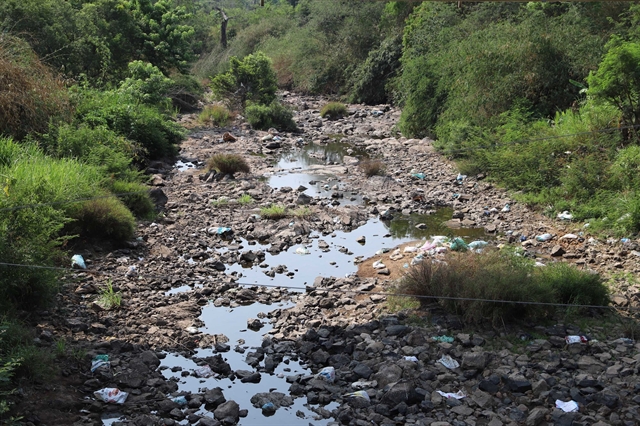 Opinion
Opinion

Vietnam News Agency talk to Châu Trần Vĩnh, deputy head of the Department of Water Resources Management under the Ministry of Natural Resources and Environment, on water security challenges and measures to tackle them.

|
| The Krong H'Năng River in Central Highlands province Đắk Lắk dried up in a photo taken on April 15, 2020. The river supplies water to tens of thousands of hectares of crops in the Ea Kar District. — VNA/VNS Photo Anh Dũng |
Vietnam News Agency talk to Châu Trần Vĩnh, deputy head of the Department of Water Resources Management under the Ministry of Natural Resources and Environment, on water security challenges and measures to tackle them.
Could you give us an overview of water shortage issues in Việt Nam this year?
This year, all regions of Việt Nam – the northern part, the central region, the Central Highlands, to the Mekong Delta – will suffer from various degrees of drought and water scarcity.
Rainfall and the flow of rivers and streams across the country has been and likely will be lower than many years’ average, continuing the disappointing water level in 2019 when we witnessed shortages even during the peak of the rainy, stormy season.
In many reservoirs – especially key ones in each of the country’s geological areas – the water level they have managed to store at the beginning of the dry season is only 40-75 per cent of their designed capacity. Worse, I have received a report of one reservoir running on 20 per cent its capacity.
The average level stored at medium and small hydropower reservoirs is 70-80 per cent at maximum, with many at 40-50 per cent of their capacity.
The Hòa Bình hydropower plant in the north, the largest of its kind in Southeast Asia with a volume of more than six billion cu.m, this year has reported a record low water level during its 30-year history.
For the northern delta region, right after the rainy season ended in September, foreseeing the inevitable dire shortage of water and subsequent impacts on energy security in the entire country – especially in the summer months of May and June, the Ministry of Natural Resources and Environment held a number of meetings with the Ministry of Industry and Trade, the Ministry of Agriculture and Rural Development and Vietnam Electricity and owners of reservoirs to discuss and come up with agreements on adjusting reservoir operation plans for different phases – the end of the flooding season, beginning of the dry season, or before each water release.
The priority was to save water and mitigate issues resulting from water shortages.
That’s why in the irrigation period for the winter-spring crop, the water supply was ensured for the fields in the north and the water remaining in large reservoirs like Hòa Binh, Sơn La, Thác Bà and Tuyên Quang could basically cover the needs of the delta for the remainder of the dry season.
For the Mekong Delta, despite the severity of drought and salinity intrusion rivalling that of the record-breaking 2016, thanks to early forecasting of the ministry, timely instructions from the Government and proactive prevention and mitigation efforts from southern localities, the loss caused to rice and other crops in the region was minimised. It’s estimated that 60 per cent of the winter-spring rice in the delta has been harvested.
This is a win for people in the Mekong Delta, however, we still urge provinces like Cà Mau, Bạc Liêu, Bến Tre and Tiền Giang to be constantly watching for the developments of drought and salt intrusion in their jurisdiction and put in place stronger measures.
Could you elaborate on the release of water from reservoirs in recent times?
The environment ministry has instructed competent authorities – especially the General Department of Hydro-Meteorology and the Department of Water Resources Management, to step up forecasting to issue timely warnings for important river basins across the country.
Our water resources department has been in close contact with major reservoirs in these regions to schedule the release of water – especially concerning important basins such as Mã River, Cả River, Hương River, Sê San River or Đồng Nai River – to balance both the goal of fulfilling the water demands downstream and the goal of retaining enough water to be used for the rest of the dry season, ahead of the spike in electricity use.
Although the lack of rainfall and flooding happened to all 11 river basins in these regions since the end of the flood season and the beginning of the dry season, so far, only a few basins run an elevated risk of water scarcity, and if properly regulated, there will be sufficient water to supply for downstream use for the remainder of the dry season.
The water resources department is asking the environment ministry to allow for a lower volume of water discharged downstream for certain struggling reservoirs, including Cửa Đại Lake (Mã River in Lào Cai Province), Bình Điền (Hương River in Thừa Thiên-Huế Province), A Vương (Vu Gia-Thu Bồn River in Quảng Nam Province), Ka Nắk (Ba River in Gia Lai Province), Se San 4 (Se San River in Gia Lai Province) and Đại Ninh (Đồng Nai River in Đồng Nai Province).
What steps is the ministry planning to deal with likely complex developments of drought and water scarcity in the coming months?
In the short-term, we are trying to raise the accuracy of our forecasts – especially concerning extreme events, and continue to closely monitor the use and exploitation of water resources, supervise the operation of reservoirs and step up the search for underground water to help alleviate water difficulties for areas where water from reservoirs can't reach.
The environment ministry, in addition, will accelerate the progress on the National Water Resources Planning, inter-provincial river basin and water resources planning, and complete the database on water resources, exploitation, use and conservation from local to central levels. — VNS




